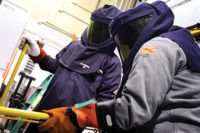NFPA 70E arc flash risk assessment is a safety study

The 2015 version of NFPA 70E introduced some changes on how you address electrical hazards in your facility. Electrical safety for your facility, and your employees, is not something you can simply check off your “to-do” list. Your program must be dynamic and constantly evolving to ensure the safety of your workers.
The fundamentals
The 2015 version of 70E places more emphasis on calculating the incident energy for your electrical equipment. The requirements for labeling equipment based on the calculated incident energy have also changed. For those who have followed NFPA 70E closely for several years, we’ve become accustomed to hearing terms like HRC (Hazard Risk Category) or “Cat 1, 2, 3, 4” ( PPE categories). Some confusion centers around the elimination of these PPE categories when/if incident energy calculations have been performed on equipment.
There is no need to panic. Updating your workers on the new NFPA 70E requirements and classifications for arc flash PPE can be handled with proper training. Your arc rated clothing systems should still be adequate, but you must ensure that the minimum incident energy rating (cal/cm^2) for the PPE is greater than the calculated incident energy rating for the equipment on which you’ll be working.
How to determine incident energy rating
To determine incident energy related to electrical equipment, you must complete an arc flash risk assessment. The four key components to an effective assessment: data collection, engineering analysis, mitigation, and equipment labeling.
Data collection, essentially an “autopsy” of the three-phase electrical distribution system, is one of the most important steps in the process. You must ensure equipment has been properly documented
for the engineering portion of the project. During data collection someone must physically visit the facility to collect information from your equipment such as wire sizes and lengths, and breaker models and settings, among many pieces of information. You can’t gather and verify this data without actually being in front of the electrical equipment with the cover removed.
One question we often receive is, “At what point in the system does the data collection end?” There are many different possible responses. Remember that an arc flash risk assessment is a safety study. The goal is to find hazards and, if possible, remove them from the system. Using that mindset, you must assess all of the equipment where your employees work--you can’t simply pick an arbitrary cut-off point in the system or estimate the hazard based on upstream devices.
We recommend following the IEEE 1584 Standard to determine the guidelines for the arc flash assessment.
Once data has been collected from the electrical distribution system, computer software is used to create a model of that system at which time single-line models are generated. Following system modeling, our common practice is a series of four engineering assessments or analyses: 1) a short-circuit analysis; 2) interrupt rating analysis: 3) protective device coordination analysis; and 4) incident energy analysis.
Calculations results must be documented and compiled into a report format so all potential hazards for the system can be summarized. It is vital that your arc flash report recommends how to mitigate possible hazards or remove them from the system. Consider mitigating hazards on equipment where employees are exposed most -- not just your main switchgear or larger pieces of equipment. Significant exposures are usually found on floor-level equipment, since this is where your employees spend most of their time servicing and adjusting the equipment. PPE is the last line of defense; it’s important to remove hazards when possible through engineering and modification to the current electrical system.
The final step
Equipment labeling and report delivery are the final step in an arc flash assessment. We recommend that all of the equipment considered in the assessment receive a label to assure workers that the piece of equipment was analyzed during initial assessment and the hazard rating is accurate.
The 2015 NFPA 70E no longer recognizes Hazard Risk Category (HRC) 0 or Category 0 – but you can essentially consider this a terminology change because the non-hazard level for less than 1.2cal/cm^2 stills exists and requires no arc flash protection, only clothing made of non-melting fibers (and shock protection if more than 50 volts). The new label for the old HRC 0 will now state that the equipment is less than 1.2cal/cm^2.
Implementing NFPA 70E can be a simple process. Be sure you implement it for the appropriate reasons. Keep safety at the forefront of the process and the rest of the pieces will fall into place. The result: you achieve both compliance and a safer workplace.
Looking for a reprint of this article?
From high-res PDFs to custom plaques, order your copy today!




